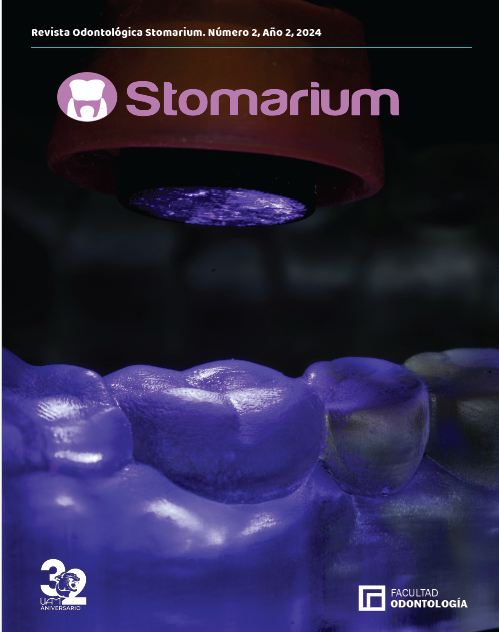Efecto del extracto y aceite esencial de semilla de uva sobre la resistencia de unión al esmalte post tratamiento de blanqueamiento dental con peróxido de hidrógeno al 35%
DOI:
https://doi.org/10.62407/ros.v2i2.175Palabras clave:
Antioxidantes, blanqueamiento de dientes, esmalte dental (DeCS)Resumen
Antecedentes: Inmediatamente después del blanqueamiento dental disminuye la resistencia de unión entre los materiales adhesivos y esmalte, se debe esperar entre 7 a 21 días para los procedimientos adhesivos. Objetivo: Evaluar la resistencia de unión al esmalte expuesto a diferentes antioxidantes post tratamiento de blanqueamiento con peróxido de hidrógeno al 35%. Materiales y métodos: Se utilizaron dientes de bovino. Todos los especímenes recibieron tratamiento de blanqueamiento con peróxido de hidrógeno al 35%, se realizó dos aplicaciones de 15 minutos cada una, por dos sesiones cada 7 días. Finalizado el tratamiento los especímenes se aleatorizaron para recibir los diferentes antioxidantes por 10 minutos sobre el esmalte, evaluando cuatro grupos: aceite de semilla de uva (ASU), extracto de semilla de uva al 5% (ESU); control negativo (blanqueamiento sin antioxidante) y control positivo (sin blanqueamiento y sin antioxidante). Posteriormente, se realizó el tratamiento adhesivo. Se midio microcizallamiento en la máquina universal y prueba de ANOVA para los valores de resistencia de unión de los diferentes grupos evaluados. Resultados: Se encontró que los grupos expuestos a los antioxidantes presentaron los valores más bajos de resistencia de unión cuando se comparó con el grupo sin blanqueamiento, sin diferencias significativas entre el aceite fijo de ESU 8,09 (3.24) MPa y el extracto de semilla de uva 8,08 (3.79) MPa (p<0.05). Conclusiones: El extracto y aceite esencial de semilla de uva disminuye la resistencia de unión al esmalte post tratamiento de blanqueamiento con peróxido de hidrógeno al 35%.
Descargas
Referencias
Abe, A. T. (2016). Effect of Bleaching Agents on the Nanohardness of Tooth Enamel, Composite Resin, and the Tooth-Restoration Interface. Operative dentistry, 41(1), 44–52.
Abraham, S. G. (2013). Effect of grape seed extracts on bond strength of bleached enamel using fifth and seventh generation bonding agents. Journal of international oral health, 5(6), 101–107.
Bansal, M. K. (2019). Impact of Different Antioxidants on the Bond Strength of Resinbased Composite on Bleached Enamel-An In Vitro Study. The journal of contemporary dental practice, 20(1), 64–70.
Barghi, N. &. (1994). Reducing the adverse effect of bleaching on composite-enamel bond. Journal of esthetic dentistry, 6(4), 157–161.
Cvitko, E. D. (1991). Bond strength of composite resin to enamel bleached with carbamide peroxide. Journal of Esthetic Dentistry, 3(3), 100–102.
Feiz, A. M. (2017). Evaluating the effect of antioxidant agents on shear bond strength of tooth-colored restorative materials after bleaching: A systematic review. Journal of the mechanical behavior of Biomedical Materials, 71, 156–164.
Kavitha, M. S. (2016). Comparative evaluation of superoxide dismutase, alpha-tocopherol, and 10% sodium ascorbate on reversal of shear bond strength of bleached enamel: An in vitro study. European journal of dentistry, 10(1), 109–115.
Kunt, G. E. (2011). Effect of antioxidant treatment on the shear bond strength of composite resin to bleached enamel. Acta odontologica Scandinavica, 69(5), 287–291.
Manoharan, M. S. (2016). Effect of newer antioxidants on the bond strength of composite on bleached enamel. Journal of the Indian Society of Pedodontics and Preventive Dentistry, 34(4), 391–396.
Mukka, P. K. (2016). An In-vitro Comparative Study of Shear Bond Strength of Composite Resin to Bleached Enamel using three Herbal Antioxidants. Journal of clinical and Diagnostic Research, 10(10), Zc89–Zc92.
Murad, C. G. (2016). Influence of 10% sodium ascorbate gel application time on composite bond strength to bleached enamel. Acta biomaterialia odontologica Scandinavica, 2(1), 49–54.
Sasaki, R. T. (2009). Effect of 10% sodium ascorbate and 10% alpha-tocopherol in different formulations on the shear bond strength of enamel and dentin submitted to a home-use bleaching treatment. Operative Dentistry, 34(6), 746–752.
Sung, E. C. (1999). Effect of carbamide peroxide bleaching on the shear bond strength of composite to dental bonding agent enhanced enamel. The Journal of Prosthetic Dentistry, 82(5), 595–599.
Titley, K. C. (1991). Scanning electron microscopy observations on the penetration and structure of resin tags in bleached and unbleached bovine enamel. Journal of Endodontics, 17(2), 72–75.
Türkmen, C. G. (2016). Effect of sodium ascorbate and delayed treatment on theshear bond strength of composite resin to enamel following bleaching. Nigerian Journal Of Clinical Practice, 19(1), 91–98.
Vidhya, S. S. (2011). Effect of grape seed extract on the bond strength of bleached enamel. Operative Dentistry, 36(4), 433–438.
Xu, Y. Z. (2018). Use of grape seed extract for improving the shear bond strength of total-etching adhesive to bleached enamel. Dental Materials Journal, 37(2), 325–331.
Publicado
Número
Sección
Licencia

Esta obra está bajo una licencia internacional Creative Commons Atribución-NoComercial-CompartirIgual 4.0.





